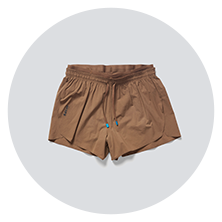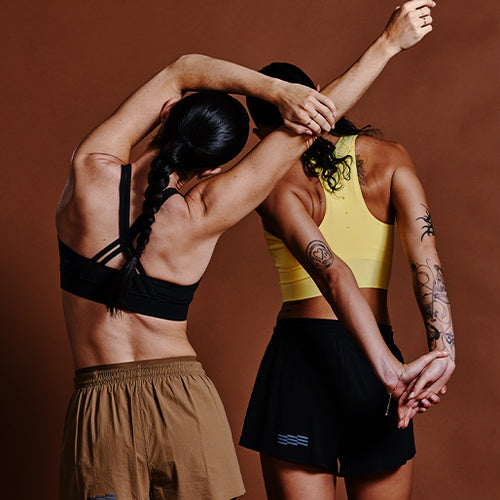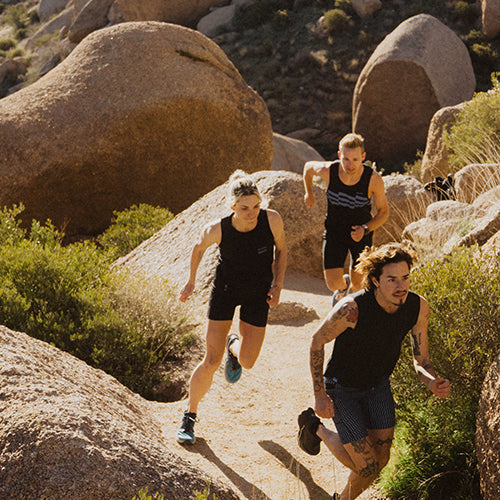Traveling face-first at 90mph on an ice track sounds pretty intimidating, but Darryl keeps his cool on steep sled runs.
Sometimes our running journeys take us to places we don't anticipate. When you live in the hot state of Texas and have a background in sprinting, you may not imagine yourself competing on a sled, racing down a frozen track, but that is exactly where Darryl Payne Jr. finds himself.
Darryl tells us how he is staying motivated these days and what preparing for the 2022 Winter Olympics Skeleton tryouts looks like, among his love for baking bread.


Janji: Tell us a bit about yourself.
Darryl: I am a man on a journey to push the limits of this athletic gift that God gave me.
J: How did you get introduced to Skeleton?
D: About 4 years ago, the US Olympic Committee hosted a scouting camp at the Olympic Training Center in Colorado Springs to find the next Olympic Hopeful for a number of sports. I attended with the original intention of being a bobsledder and I was killing it! However, by the end of the camp, the Head Coach of Bobsled as well as the CEO decided that I was too small. I'm 5'10, 165lbs and they needed someone that was at least 225lbs. They did offer me an invitation to try-out Skeleton, though. That's when I fell in love.
 |
 |
J: What is Skeleton?
D: I asked the same thing when I was recruited for it. Skeleton is one of the 3 sliding sports to take place in the winter olympics. I always explain it by saying it's similar to Luge because it takes place on the same icy, serpentine track but it's head first...and my head is centimeters from the ice. Even though I can reach speeds of 90mph, I'm still safer than I would be with Bobsled or Luge. Bobsled involves a 400+ pound sled that can drag me under it in a crash, Luge is super aerodynamic and much faster, so if/when I crash, catching air is a dangerous possibility.
J: What sports did you pursue before Skeleton?
D: Before jumping into Skeleton, I was a hurdler and quarter-miler. That sprinting background made me an excellent candidate for the sport because explosive power is key.
“I'm a rare-breed that loves to just build-up fuel so the fire I light holds a magnificent presence. Motivation for me is the desire to change the sport by being the first black man to compete for Team USA in Skeleton. |
 |
J: What does your typical training look like? Has it been impacted by COVID?
D: In terms of my training, nothing has changed for me in transition to Skeleton nor has anything changed because of the pandemic. I keep up the regiment of a track athlete and fly to New York, Utah, Canada, or Europe for practice on ice in the winter months since, you know, that Texas heat is hostile to anything cold. A typical week has 5 sprint workouts, 3 strength training workouts, 3 Olympic lifting workouts, and 2 core performance workouts (these are more like active recovery, not very hard). I also have to take care of my body so massages, ice baths, and such are also mixed in there. In winter, things change up a bit because sprints are mostly replaced with sliding. If there were no diseases outside shutting the world down, I would be sliding about 12-15 times a week.
J: How have you stayed motivated this year?
D: I'm a rare-breed that loves to just build-up fuel so the fire I light holds a magnificent presence. Motivation for me is the desire to change the sport by being the first black man to compete for Team USA in Skeleton. It's pretty ever-present honestly. I have my down days, of course, but they don't last long.
 |
 |
J: How do you mentally prepare for doing something like Skeleton?
D: Even though I'm somewhat of an adrenaline junky, something about going 90 mph on your belly can set you straight. I learned to use breathing techniques and a bit of meditation/visualisation to keep me centered and calm enough to slide down that mountain.
 |
 |


 |
 |
J: What lessons has Skeleton taught you?
D: Skeleton season happens right in the middle of track season, my first love. I had to put competition on the back burner while I figured out this new sport and that was the most unsettling. That and the fact that this sport is crazy expensive. I went through mental bouts questioning if I made the right decision because I don't have the financial infrastructure to support myself like the veterans do for themselves. I think that mental struggle affected me physically, but eventually I recognized that I'm a world-class athlete that hasn't competed on the world-stage yet. The gain in mental strength and the discipline required to maintain it has been the biggest lesson learned. A lot of prayer and mentorship led me through that lesson. In short, I focus on the stuff I can control, my strength, speed and mental resilience, and let God handle the mountain of gaining financial support.
 |
 |
 |
 |
“We have some crazy athletes that could contribute to Team USA in a major way at the Olympics across all winter sports. I want to help open that door wider so the light of possibility hits as many eyes as possible. |
J: What would it mean for you to be the first African American to represent the US in a Winter Games Skeleton?
D: If you look at make up of Team USA, you notice a lack color, a little less than 9% of the 2018 Olympic team was non-white. Our 2016 team was at 23%. My presence in Skeleton would help boost that number, but an even greater reward will be to open up another athletic option to young black athletes that didn't even know it existed. We have some crazy athletes that could contribute to Team USA in a major way at the Olympics across all winter sports. I want to help open that door wider so the light of possibility hits as many eyes as possible.
“Don't sweat the small stuff, you already got this. |
 |
J: What’s the best advice you’ve ever received?
D: “You don't have to conceptualize or analyze every thought that comes into your awareness. Be still and in that stillness, you are your truest self of consciousness." Translation: Don't sweat the small stuff, you already got this.
 |
 |
“Eyes with pride. Never stop."
J: Got a mantra?
D: My mantra is "Eyes with pride. Never Stop." The first part puts all of me in check, mentally, emotionally, physically, all of it. The second part is just that, never stop, because I want it that bad.
J: Is that your dog?
D: Teddy is not my dog! That's Weston, the photographer's dog. I want a dog so bad though! I would love to have a greyhound as my fur best friend. A perfect match right?!
 |
 |
J: You’re also a trainer, what is the most important/foundational thing you teach your clients?
D: I love how the body moves as a system and a unit, so I always start off my first few sessions focusing on just that with new clients and make sure to revisit it down the road.
J: And you're a chef! What got you into the culinary arts?
D: I've been cooking since I was 7 years old. Then my family moved to Lafayette, Louisiana, so you know I had to learn about the glue that food is for people and communities. Eventually it became a huge passion that I pursued after Baylor.
J: What’s your favorite dish to prepare? What’s your go to homemade meal for pre-race fuel?
D: I love making anything that has a few ingredients, but requires a lot of technique, most notably bread. It's almost like it lives and breathes and you have to nurture it into a mature loaf that brings a wide smile to everyone that eats it. Pre-race meals are different though. I’m always so nervous that I can’t eat. I probably just stick with a granola bar and a lot of water.
 |
 |
 |
Photo Credit
Weston Carls, @westoncarls on IG
Follow Darryl on IG @darrylpaynejr and check out his website for a first-person Skeleton ride and to hear more of his story.
Get the Look




















